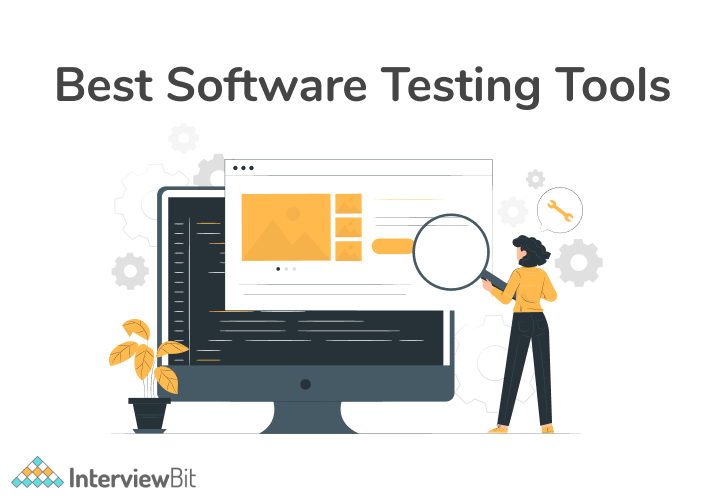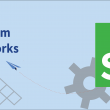What is Software Testing?
Software testing is a process for determining whether or not the software product meets the anticipated criteria and ensuring that the software product is free of defects. Software/system components are executed using either human or automated methods to assess attributes relevant to the user. The goal of software testing is to uncover mistakes, gaps, or missing requirements compared to the real requirements of the product being tested.
Simply put, software testing is the process of verifying the application under test (AUT). If you are wondering what is the importance of software testing? Then, it is essential because it allows any faults or mistakes in the software to be found early and fixed before the software product is delivered. A well-tested software product provides dependability, security, and excellent performance, saving time and money and improving customer satisfaction.
Professional software testers combine manual and automated testing techniques. The testers communicate the findings to the development team after executing the tests. The ultimate objective is to provide the consumer with a high-quality product.
Confused about your next job?
What are Testing Tools?
The tools used for software testing are known as software testing tools. Software testing tools often ensure that software products are robust, comprehensive, and work well. Software testing tools may be used to do unit testing and then integration testing. These tools are utilized to meet all of the criteria of the testing operations that have been scheduled. Product testers use a variety of testing technologies to assess the quality of the software.
Testing Tools: There are two forms of software testing: static testing and dynamic testing. The instruments that were utilized during these tests were also given names that corresponded to the tests. The following are the two kinds of testing tools available:
- Static Test Tools
- Dynamic Test Tools
The following is a detailed explanation of each of these:
Static Test Tools: Static test tools are used to carry out static testing. These tools do not simulate the software’s actual operation. In these tools, certain input and output are not necessary. The following are examples of static test tools:
- Flow analyzers: Flow analyzers allow data to flow freely from input to output.
- Coverage Analyzers: The coverage analyzers ensure that all rationale paths in the software are protected.
- Interface Analyzers: They examine the ramifications of passing variables and data between modules.
Dynamic Test Tools: Dynamic test tools are used to perform dynamic testing. These tools put the software through its paces using real-world data. The following are examples of dynamic test tools:
- Test Driver: The input data to a module-under-test is provided by the test driver (MUT).
- Test Beds: It simultaneously displays source code and the program being executed.
- Emulators: Emulators are response facilities used to imitate parts of a system that have not yet been developed.
- Mutation Analyzers: They are used to test the system’s fault tolerance by intentionally introducing errors into the software code.
There is a myriad of software testing tools on the market, and with so many options, it may be tough to choose the ideal testing tools for your project. So, we have listed down 20 testing tools along with their features depending upon the different categories.

Mobile Testing Tools
Mobile Testing Tools assist you in automating the testing of your Android or iOS apps. The following testing tools are:
Appium:
Appium is an open-source testing solution for mobile apps that automates testing. It enables customers to test various programs, including native, mobile, web, and hybrid. It also facilitates the use of emulators and simulators for automated testing.
Features:
● Test the same app that will be released on the market.
● It’s a basic program that only requires a small amount of memory throughout the testing process.
● Native app testing does not need the usage of an SDK; instead, it provides standard automation APIs that you may use on a variety of platforms.
Espresso:
Espresso is a business-oriented mobile testing solution. It’s incredibly simple to use as an open-source tool, and you may extend it inside that working environment. Without writing a single line of test code, this test recorder tool enables you to create UI tests for your mobile app.
Features:
● Less Mobile Testing Flakiness with the Espresso Workflow
● Developers get timely and consistent feedback.
● Espresso test automation is simple to create.
Perfecto:
It is a cloud-based software testing platform that enables app developers to test web, mobile, and IoT applications in real-time. Customers may also use this tool to determine the deployment choices that are most appropriate for their particular project.
Features:
● Testing of mobile applications over the cloud
● It assists with the Agile Environment.
● It is possible to combine the tool with other quality assurance testing tools such as Selenium and Appium.
ExperiTest:
Experitest is a quality control tool for mobile developers that Experitest developed. Manual testing, performance testing, and load testing for mobile apps are all included in the package. This testing tool is compatible with all mobile operating systems, including iOS, Android, Windows Phone, and Blackberry.
Features:
● Create and run automated tests on simulators or emulators that are housed in Experitest data center facilities.
● Use the same test script for multiple mobile operating systems by recording and replaying tests and automatically recording tests to code.
● It provides reports that include video or HTML-based reporting on a screen.
● View the element structure of mobile applications and create IDs with relative simplicity.
Robotium:
Robotium is a transparent test automation tool that is mostly used for Android user interface testing. It can run both native and hybrid programs simultaneously. With the aid of this program, it can carry out System Testing, functional testing, and user acceptability testing for Android-based applications, among other things.
Features:
● In minutes, you may record Android UI test cases.
● Provide support for recordings made using emulators and real devices.
● Complete support for native and hybrid Android applications, including automatic resource ID detection.
API Testing Tools
Testing the REST/SOAP protocols is made easier with the aid of these testing tools.
SoapUI:
SoapUI is one of the greatest testing tools since it is a cross-platform open-source tool for functional SOAP and REST testing built in Java. It is generally used to test APIs for functionality and load.
Features:
● The software’s graphical user interface is simple to navigate and utilize.
● The vulnerability testing function aids in the protection of websites from hackers and malware.
● With its reporting function, it is able to do extensive analysis.
● SQL Injection provides several typical SQL queries and techniques for identifying the application’s weak points.
SOAPSonar:
SOAPSonar is an API Testing tool that focuses on automating the process of developing and maintaining test cases. It enables independent testing of each service from the client application while grouping the test procedure for automation. Additionally, these test cases do not need any programming or scripting expertise to create or execute.
Features:
● Validation of SOAP, XML, and REST services
● Performance Profiling and Concurrent Client Load Testing with the Success Rule Framework
● Web-based service Security Examinations in conjunction with Risk Mitigation
WebInject:
WebInject is the finest API testing solution for testing online applications and web services in an automated manner. Additionally, it may be used to evaluate specific system components using HTTP interfaces and to run automated functional, regression, and acceptability tests.
Features:
● At the time of test execution, you may observe HTTP response times in real-time.
● Combine online testing with mobile and desktop graphical user interface testing.
● During the runtime, timer statistics are computed and shown.
Tricentis:
Tricentis is an application programming interface (API) testing tool that aids in the management of test cases. By compiling and running test cases, significantly decreases testing time, human labor, and expenses.
Features:
● It provides self-contained SAP Testing.
● SAP Test Automation Capabilities that are mature and strong.
● Integration with Solution Manager
Automated Testing Tools
This group of tools aids in the automation of functional and regression testing of your application.
Avo Assure
Avo Assure is a no-code automation testing platform that allows you to test end-to-end business processes with only a few mouse clicks. Testing is smooth across web, desktop, mobile, ERP apps, mainframes, related emulators, and more because it is heterogeneous.
Features:
● Create and run test scenarios without having to write any code.
● Achieve E2E test automation and coverage of above 90%.
● Make accessibility testing possible.
● Use the Mindmaps tool to create test plans and test cases.
Kobiton
Testing and development teams may use Kobiton to automate Functional, Performance, Visual, and Compatibility testing on actual mobile and IoT devices.
Features:
● Local devices may be “cloudified” for shared remote access in a public or private cloud.
● On-premises deployments
● It is automated without scripts or programmed support for top open-source automation tools and frameworks for functional, performance, visual, and compatibility testing.
Parasoft Continuous Quality Suite
The automated software testing solutions from Parasoft incorporate quality into the software delivery process to catch errors early and fix them. Parasoft’s continuous quality suite covers static code analysis, unit testing, code coverage, API testing, service virtualization, and UI testing, allowing for rapid delivery while still meeting industry and security requirements.
Features:
● development and execution of tests aided by machine learning
● Testing of a low-code program
● Comprehensive reporting and analysis dashboards
ZAPTEST
ZAPTEST is a Software Automation solution for any company that utilizes software for operations or development and wants to automate back-office operations or software testing procedures while also developing a revolving automation framework.
Features:
● Automated Functional and Performance Testing
● RPA stands for Robotic Process Automation (Robotic Process Automation)
● RPA Software Automation + Seamless testing
● Execution on Multiple Platforms (Parallel)
Selenium:
One of the most widely used software testing tools is Selenium. It was created to automate functional portions of web-based applications across a wide variety of platforms and browsers.
Features:
● It’s one of the greatest QA tools since it supports parallel test execution, which reduces the time it takes to run parallel tests.
● When compared to other manual testing solutions, Selenium requires much fewer resources.
● You may run this testing tool’s test cases on any operating system.
● Many well-known programming languages are supported, including Java, Python, C#, Perl, PHP, and JavaScript.
QTP:
Quick Test Professional (QTP), currently known as Micro Focus UFT (Unified Functional Testing), is a functional GUI testing tool that automates user activities on a web or client-based computer application. It’s a popular tool for automating functional regression tests. It is a manual testing tool that manipulates the objects and controls of the application under test using a scripting language.
Features:
● QTP is one of the software testing tools that novice testers may pick up in a matter of minutes.
● The tool is incredibly simple to use. It shows the tester a test case in a basic procedure.
● Through a comprehensive set of checkpoints, the tool enables thorough application evaluation.
Defect Tracking Tools
This category of testing tools is designed to assist with defect/bug management.
JIRA:
JIRA is a defect tracking and project management program that you may use to track defects and issues. This tool is utilized for recording and reporting and is also directly connected with the code development environment.
Features:
● With JIRA Query Language, you can quickly define filters with a single click.
● It is possible to construct bespoke processes of any size, which is beneficial for software development, testing, and release.
● Install plug-and-play add-ons from The Atlassian Marketplace to accommodate a variety of scenarios.
Mantishub:
Mantis is an open-source defect tracking application that strikes a good mix between capability and simplicity. As a result, users may quickly learn how to utilize this application to manage their peers and customers efficiently.
Features:
● Boost the organization’s workflow and efficiency.
● The internal problem tracking assistance
● This utility enables Bitbucket and GitHub single-sign-on.
● MantisHub includes a built-in time monitoring function that helps you track how much time you spend on each problem.
FogBugz:
FogBugz is a defect and change tracking tool you may use in ongoing software projects such as application development and deployment. It’s especially useful for companies that need to monitor defects across several projects.
Features:
● Fogbugz gives you the freedom to access information quickly.
● It helps in the administration of Agile projects.
● Notifications and emails keep team members informed about project and case changes.
Bugzilla:
One of the greatest defect tracking systems is Bugzilla. Individuals or groups of developers may use the application to keep track of open bugs in their system. It is the greatest open-source software available, and both small and big businesses utilize it.
Features:
● Performance and scalability have been improved by optimizing the database structure.
● Advanced query tool that remembers the user’s personalized searches
● User profiles that may be edited and extensive email preferences
● Installations with a lot of customizability might benefit from an extension mechanism.
BugNet:
BugNet is a free and open-source bug-finding program. It’s a cross-platform application built on the ASP.NET framework that uses MySQL as its backend database. This defect tracking tool’s major goal is to make codebases simple and easy to deploy.
Features:
● It’s a GPL-licensed open-source web application.
● The BugNET tool makes filing, managing, and reporting issues a breeze.
● The program supports multiple databases.
● Provide simple navigation and management.
Conclusion
We hope that these 20 testing tools of different categories will help you in the software testing industry. If you have any other doubt, please feel free to ask in the comment section below.
FAQs
Q1: What are manual testing tools?
Ans: The process of manually checking software for faults is known as manual testing. It necessitates a tester acting as an end-user and using most of the application’s functionalities to guarantee proper behaviour. It has eight testing tools such as:
- Selenium.
- JMeter.
- Loadrunner.
- Test Link.
- QTP.
- Quality Center (ALM)
- Bugzilla.
- Mantis.
Q2: Is Jira a testing tool?
Ans: Atlassian, an Australian company, created JIRA, a software testing platform. It’s a bug-tracking application that keeps track of all the problems with your software or mobile apps. JIRA is derived from the Japanese term “Gojira,” which means “Godzilla.”
Q3: What is a manual testing example?
Ans: Manual Testing Example is Testing a piece of software’s end-to-end flow. Acceptance testing should be performed on a real estate application that enables users to submit photographs and generate real estate listings.
Additional Resources
- Software Testing MCQ
- Automation Testing Tools
- Manual Testing Tools
- API Testing Tools
- Performance Testing Tools
- Automation Testing Interview Questions
- Selenium Interview Questions
- Software Testing Interview Questions
- Difference Between Testing and Debugging
- Principles of Software Testing
- Difference Between Alpha and Beta Testing




